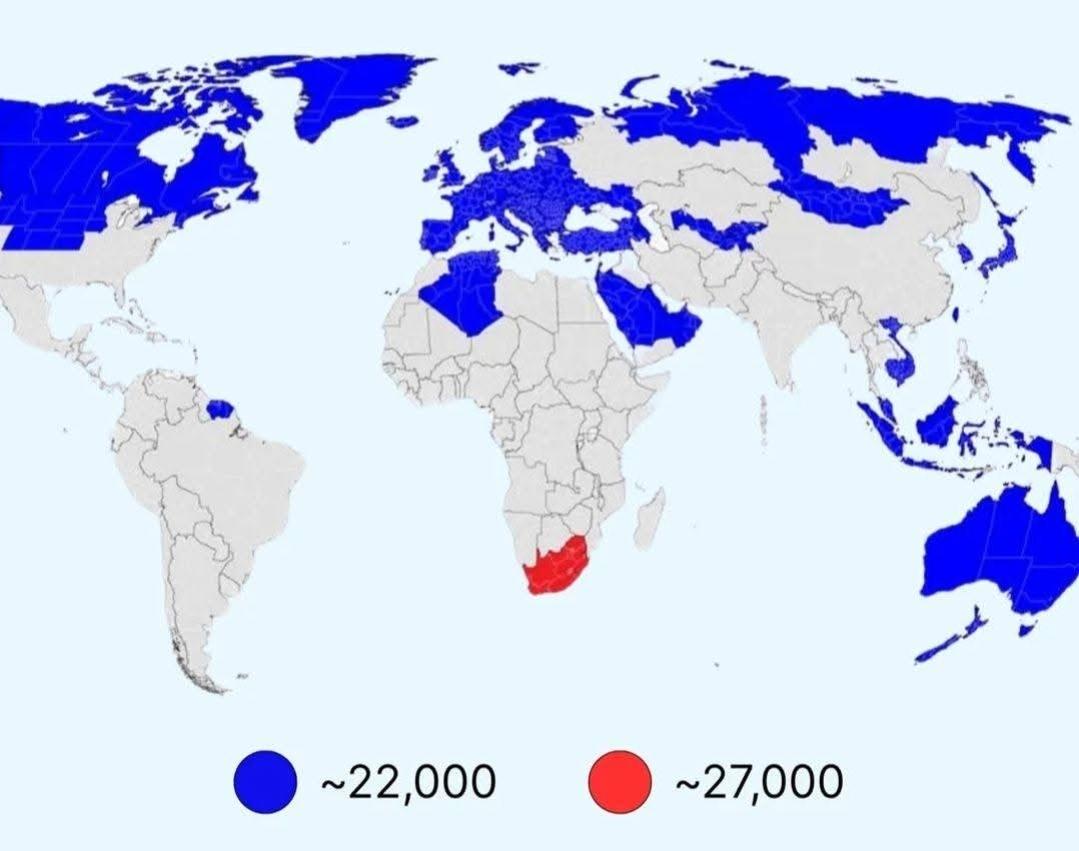South Africa Murder Rate Comparison Map


David Chen
Data Visualization Specialist
David Chen is an expert in transforming complex geographic datasets into compelling visual narratives. He combines his background in computer science ...
Geographic Analysis
What This Map Shows
This map provides a stark visualization of murder rates in South Africa, highlighting the alarming fact that the country experiences more murders than all the blue regions combined. The blue areas represent various countries around the world with lower murder rates, underscoring the severity of violence in South Africa. This visualization serves as a critical reminder of the pressing issues surrounding safety and crime in certain regions.
Deep Dive into Murder Rates in South Africa
Murder rates are a significant indicator of societal health, reflecting not just crime levels but also underlying factors such as poverty, inequality, and social cohesion. South Africa has long struggled with high levels of violence, a legacy of apartheid and systemic inequality. In 2022, the country recorded over 24,000 murders, translating to a murder rate of approximately 35 per 100,000 people. This rate is one of the highest globally, comparable to countries experiencing civil unrest or severe gang violence.
Interestingly, the nature of violent crime in South Africa is multifaceted. While gang violence and organized crime are prevalent in urban areas, domestic violence also plays a significant role in the murder statistics. According to the South African Police Service, many murders occur within the context of personal relationships, highlighting a concerning trend in domestic abuse.
Moreover, the geographical distribution of murder rates across South Africa is uneven. For example, provinces like the Western Cape, particularly in urban areas like Cape Town, report exceptionally high murder rates, often linked to gang-related activity. In contrast, rural areas tend to have lower rates, although they are not immune to violence. This discrepancy raises questions about the effectiveness of law enforcement and community safety initiatives in different regions.
The demographics of victims and perpetrators also reveal important insights. Young men, particularly those aged 15 to 29, are disproportionately affected by violent crime, both as victims and offenders. This demographic trend is alarming and suggests a need for targeted interventions focusing on youth empowerment and community support.
Regional Analysis
Examining the map further, we can see distinct patterns between provinces in South Africa. For instance, Gauteng, the economic powerhouse of the country, has high murder rates driven by urbanization, economic disparity, and high levels of migration. Johannesburg, often referred to as the 'City of Gold,' sees a high influx of people seeking better opportunities, which can sometimes lead to increased competition and, unfortunately, violence.
On the other hand, provinces like the Eastern Cape and Limpopo, while still facing challenges, report lower murder rates. Factors such as community cohesion, cultural values, and local governance may play a role in these differences. For example, rural communities often have stronger social networks that can deter crime, contrasting sharply with the anonymity and isolation found in sprawling urban environments.
Interestingly, while South Africa's overall murder rate is alarmingly high, there are pockets of communities actively working towards reducing violence. Initiatives focusing on youth engagement, community policing, and empowerment programs have shown promise in specific areas, leading to a decline in crime rates over time. However, the challenge remains significant, requiring a multifaceted approach that addresses the root causes of violence.
Significance and Impact
Understanding the murder rate in South Africa is not merely an academic exercise; it has profound implications for policy, social stability, and economic development. High levels of violence deter investment, tourism, and can lead to brain drain, where skilled individuals leave the country in search of safer environments. This creates a vicious cycle that perpetuates poverty and inequality.
Current trends indicate a potential shift in how violence is perceived and addressed in South Africa. There is a growing recognition of the need for comprehensive strategies that incorporate social, economic, and educational aspects to combat crime. Policymakers are beginning to focus more on prevention rather than just punitive measures.
As we look to the future, it is crucial to continue monitoring these trends and supporting initiatives that aim to reduce violence. The map serves not only as a reflection of the current situation but as a call to action for communities, leaders, and individuals to work together in creating a safer South Africa for everyone. Have you ever considered how connected societal issues are to the rates of violence we see today? Tackling these challenges requires a collective effort and a commitment to change.
Visualization Details
- Published
- October 27, 2025
- Views
- 12
Comments
Loading comments...